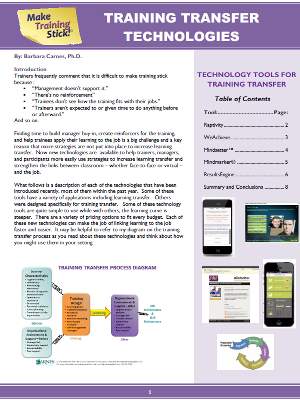Keeping Learning Sticky After the Online Learning Event
After a learning event, the learner’s ability to recall information significantly declines over time when there is little to no attempt to retain the information (Ebbinghaus Forgetting Curve). It is necessary that the learner practice in the formal learning setting and practice beyond the initial online learning experience.
Of course, when class is over, our work is not complete! How can we (facilitators) help reinforce knowledge and application after the learning event?
After the learning event, facilitators can boost knowledge application and transfer by applying Techniques to Integrate into Education (TIEs) to learners (and their managers) who have recently attended a learning event. Practical ways the facilitator can accelerate learner transfer after the online learning event can be achieved by
- Emailing the learner and manager immediately after the learning event, outlining the course objectives, practice examples, attaching useful job aids, practice examples, where he/she can find additional resources for learning, inspiration to build self confidence and apply the knowledge and skills learned, and next steps for promoting transfer and application.
- Arranging a meeting with both the learner and the manager or request the manager meet with the learner to discuss objectives. Ask managers to hold the learner accountable for using the skills. Apply the Use It or Lose It Checklist or the Training Contract.
- Encouraging learners to be self-aware of how and when they learn best so they can communicate the information to their manager.
- Requesting the manager provide the learner a mentor within his/her workgroup.
- Providing refresher training on content and application.
- Working directly with the manager to ensure the learner is given a designated space and time to practice concepts learned. Strategically schedule practice at a time when learners will learn the most.
- Encouraging managers and learners to schedule practice at widely spaced intervals in time to build brain power and overcome delayed performance, allowing time for the learner to self-reflect.
- Asking the manager to formalize the practice with identical real work scenarios and allow the learner to apply knowledge in various scenarios, placing special emphasis on the activity’s strategic link to the organization. This would include retrieval practice (free recall, cued recall, recognition).
- Encouraging managers and mentors to delay feedback to increase retention and transfer, giving the learner a chance to make mistakes and learn from those mistakes.
- Asking the manager to create an online threaded discussion covering specific training topics to promote collaboration and discussion. See Keeping Learning Sticky with Social Media, Part I and Keeping Learning Sticky with Social Media, Part II.
No doubt, the manager, learner, and facilitator all play key roles when it comes to training transfer, but facilitators should utilize certain techniques to accelerate learner transfer and encourage communication early on among the learner and the manager. Without practice it is very unlikely that the objectives of any learning program will be retained long term. More information on additional practical techniques to integrate into training for effective learning and transfer are in Barbara Carnes’ books, Making Learning Stick and Making eLearning Stick (on Amazon).
Visit our website at maketrainingstick.com! Until next time… Dr. TL


